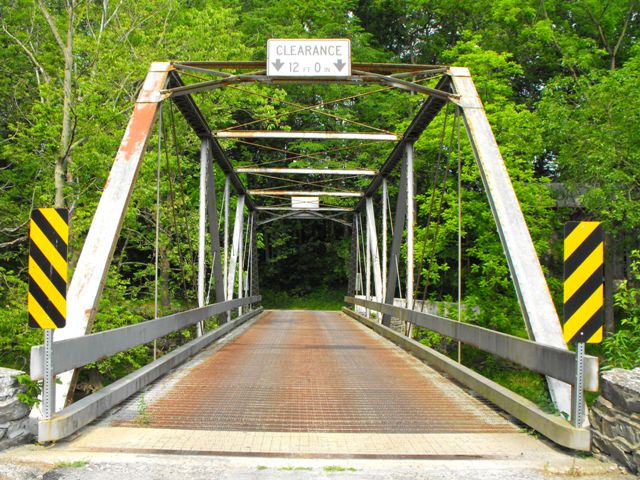We Recommend:
Bach Steel - Experts at historic truss bridge restoration.
BridgeHunter.com Phase 1 is released to the public! - Visit Now
Bairs Mill Bridge

Primary Photographer(s): Nathan Holth and Rick McOmber
Bridge Documented: May 31, 2010
Rural: York County, Pennsylvania: United States
1893 By Builder/Contractor: Wrought Iron Bridge Company of Canton, Ohio
Not Available or Not Applicable
87.0 Feet (26.5 Meters)
87.0 Feet (26.5 Meters)
12.5 Feet (3.81 Meters)
1 Main Span(s)
66721207733064

View Information About HSR Ratings
Bridge Documentation
This bridge no longer exists!
View Archived National Bridge Inventory Report - Has Additional Details and Evaluation
This historic bridge was demolished and replaced in 2012!
This bridge is a six panel pin-connected Pratt through truss. It has been altered by the addition of two beams which have been welded to the truss, and an added pier which essentially turn the single span bridge into a two-span continuous truss. Given the number of better and unaltered examples of this bridge type which have been demolished in York County, this bridge today is far more rare and significant on an individual basis than it was in years past despite this alteration. Also, aside from this alteration, the bridge still retains most of its original materials and design, including original builder plaque. Further, the historic bridge contributes to a potential historic district, since the bridge is located next to a historic mill complex. The bridge and mill are today are rare example of an intact scene that would have been commonplace at the turn of the 20th Century, which is a mill along a river with a bridge located right next to the mill. Often, the bridges were built to provide access to and serve the needs of the mill.
All of these areas of significance and rarity are meaningless to PennDOT and other involved agencies who decided that the only way to deal with a historic bridge that serves a mere 140 cars a day, was not found structurally intolerable by the National Bridge Inventory, had no structural evaluation rating lower than "Poor," and clearly could have been rehabilitated for less than the cost of replacement given those ratings is to demolish the bridge and replace it with a slab of pre-stressed concrete box beams.
As required by federal law, the bridge is being marketed for relocation and preservation by a third party, however nobody has stepped forward. This is a bridge that should not have to be moved, since it is clear that a rehabilitation would keep it a safe and functional crossing for the light vehicular traffic it serves for decades to come. Further, relocating the bridge would separate it from the potential historic district it contributes to. However in Pennsylvania, finding a third party to relocate and preserve the bridge is usually the only way to save a bridge, since PennDOT tends to be somewhat lacking in compromise and common sense when it comes to determining the feasibility of preserving a historic bridge in place.
Information and Findings From Pennsylvania's Historic Bridge InventoryDiscussion of Bridge The 90'-long, pin-connected, metal Pratt thru truss bridge built in 1893 has been converted from a single span to two spans by the addition of a concrete pier underpinning the floorbeam at midspan (1954). The midpanel diagonal eye bars have been strengthened by weld-connected I beams and gusset plates at the panel points. The bridge has double-looped floorbeam hangers in the end panels, a trademark of the fabricator, the Wrought Iron Bridge Co. The bridge is an altered example of a bridge type/design and fabricator that are well represented by other more complete examples in the county. It is not individually distinguished, however, it does have the integrity necessary to contribute to the potential Strickler Mill historic district. It is from the district's period of significance, and it is within the boundaries of the district. Discussion of Surrounding Area The bridge carries a 1 lane road over a stream at Strickler Mill. The 1878 brick mill building complete with machinery (non-operable) is at the northwest quadrant. There are also a ca. 1878 brick residence at the southwest quadrant and a barn at the southeast quadrant. A stone dam is upstream. The mill complex has the cohesiveness and integrity of a potential historic district. Bridge Considered Historic By Survey: Yes |
![]()
Photo Galleries and Videos: Bairs Mill Bridge
Bridge Photo-Documentation
Original / Full Size PhotosA collection of overview and detail photos. This gallery offers photos in the highest available resolution and file size in a touch-friendly popup viewer.
Alternatively, Browse Without Using Viewer
![]()
Bridge Photo-Documentation
Mobile Optimized PhotosA collection of overview and detail photos. This gallery features data-friendly, fast-loading photos in a touch-friendly popup viewer.
Alternatively, Browse Without Using Viewer
![]()
Eastbound Crossing of the Bridge
Full Motion VideoStreaming video of the bridge. Also includes a higher quality downloadable video for greater clarity or offline viewing.
![]()
Maps and Links: Bairs Mill Bridge
This historic bridge has been demolished. This map is shown for reference purposes only.
Coordinates (Latitude, Longitude):
Search For Additional Bridge Listings:
Bridgehunter.com: View listed bridges within 0.5 miles (0.8 kilometers) of this bridge.
Bridgehunter.com: View listed bridges within 10 miles (16 kilometers) of this bridge.
Additional Maps:
Google Streetview (If Available)
GeoHack (Additional Links and Coordinates)
Apple Maps (Via DuckDuckGo Search)
Apple Maps (Apple devices only)
Android: Open Location In Your Map or GPS App
Flickr Gallery (Find Nearby Photos)
Wikimedia Commons (Find Nearby Photos)
Directions Via Sygic For Android
Directions Via Sygic For iOS and Android Dolphin Browser
USGS National Map (United States Only)
Historical USGS Topo Maps (United States Only)
Historic Aerials (United States Only)
CalTopo Maps (United States Only)


